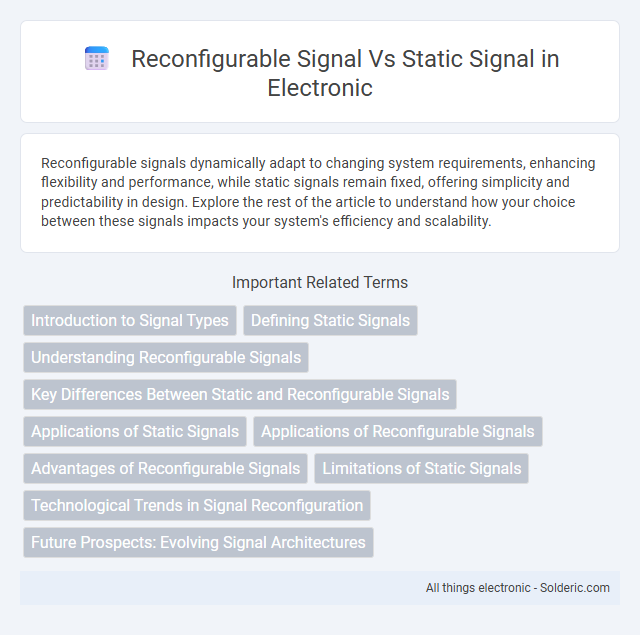Reconfigurable signals dynamically adapt to changing system requirements, enhancing flexibility and performance, while static signals remain fixed, offering simplicity and predictability in design. Explore the rest of the article to understand how your choice between these signals impacts your system's efficiency and scalability.
Comparison Table
| Feature | Reconfigurable Signal | Static Signal |
|---|---|---|
| Definition | Signal whose parameters can be dynamically changed during operation. | Signal with fixed, unchanging parameters after initialization. |
| Flexibility | High - can adapt to different conditions or requirements. | Low - remains constant throughout usage. |
| Use Cases | Adaptive systems, software-defined radio, cognitive radio. | Traditional fixed-function systems, legacy communication protocols. |
| Complexity | Higher due to need for control mechanisms. | Lower, simpler implementation. |
| Performance | Optimized dynamically for varied environments. | Consistent but potentially suboptimal in changing conditions. |
| Cost | Generally higher due to advanced hardware/software. | Lower due to simpler design. |
| Examples | Dynamic frequency modulation, adaptive waveform generation. | Fixed frequency tone, constant waveform output. |
Introduction to Signal Types
Reconfigurable signals adapt dynamically based on environmental or system conditions, enhancing flexibility in communication and processing systems. Static signals maintain fixed properties throughout transmission, ensuring consistent and predictable performance. Understanding these core differences is essential for optimizing signal handling in advanced electronic and telecommunication applications.
Defining Static Signals
Static signals maintain a constant value or state throughout their operation, representing fixed data or control paths in digital circuits. These signals do not change during runtime, ensuring predictable and stable behavior ideal for fixed hardware logic. Understanding static signals helps you design reliable systems where signal predictability and consistency are critical.
Understanding Reconfigurable Signals
Reconfigurable signals dynamically adapt their parameters such as frequency, amplitude, or phase in response to changing system requirements or environmental conditions, enhancing communication flexibility and efficiency. Unlike static signals that maintain fixed characteristics, reconfigurable signals support cognitive radio systems and adaptive filtering by enabling real-time modulation and spectrum management. This capability improves resilience to interference and optimizes spectrum utilization in wireless communication networks.
Key Differences Between Static and Reconfigurable Signals
Static signals maintain fixed properties and configurations throughout their operation, offering consistent performance but limited adaptability. Reconfigurable signals dynamically adjust parameters such as frequency, amplitude, or modulation schemes in real-time to optimize system performance for varying conditions. Key differences include flexibility, with reconfigurable signals enabling multi-functional use cases versus the rigidity of static signals, and implementation complexity, where reconfigurable systems require advanced control algorithms and hardware support.
Applications of Static Signals
Static signals are extensively used in embedded systems for controlling fixed hardware components, such as sensor status indicators and simple on/off devices, where consistent and predictable signals are essential. In industrial automation, static signals enable reliable monitoring and control of machinery states, ensuring safety and efficiency in processes. These signals also play a crucial role in legacy communication protocols and electronic devices where signal patterns remain constant over time for stability.
Applications of Reconfigurable Signals
Reconfigurable signals enable dynamic adaptation in communication systems, making them ideal for cognitive radios, adaptive radar, and software-defined radio applications where environmental conditions vary continuously. These signals enhance spectrum efficiency by allowing devices to modify waveform parameters in real-time to avoid interference and optimize channel capacity. Additionally, reconfigurable signals support multi-standard wireless platforms, facilitating seamless transitions between different communication protocols and improving overall network flexibility.
Advantages of Reconfigurable Signals
Reconfigurable signals offer significant advantages in modern communication systems by enabling dynamic adaptation to varying environmental conditions and user requirements, thus improving spectral efficiency and reducing interference. These signals support flexible modulation schemes and bandwidth allocation, enhancing system performance and energy efficiency compared to static signals that operate on fixed parameters. The ability to reconfigure allows for real-time optimization, supporting diverse applications such as cognitive radio, 5G networks, and adaptive radar systems.
Limitations of Static Signals
Static signals have fixed properties and lack adaptability, limiting their effectiveness in dynamic environments where signal conditions frequently change. These signals cannot adjust modulation schemes, frequency, or power levels in real time, resulting in reduced efficiency and increased interference. You may experience diminished performance and reduced communication reliability when relying solely on static signals in modern wireless systems.
Technological Trends in Signal Reconfiguration
Reconfigurable signals leverage advanced field-programmable gate arrays (FPGAs) and software-defined radio (SDR) technologies, enabling real-time adaptability in communication systems compared to static signals fixed in hardware. Emerging trends emphasize machine learning integration for dynamic signal modulation and adaptive frequency allocation, enhancing spectrum efficiency and reducing interference. Your ability to deploy reconfigurable signals facilitates faster innovation cycles and improved resilience in next-generation wireless networks.
Future Prospects: Evolving Signal Architectures
Future signal architectures emphasize reconfigurable signals due to their adaptability and enhanced performance in dynamic environments, unlike static signals that lack flexibility. Reconfigurable signals enable real-time modification of parameters such as frequency, phase, and amplitude, supporting advanced communication standards and cognitive radio technologies. Your ability to leverage these evolving signal designs will drive innovation in wireless systems, ensuring scalability and resilience for next-generation networks.
reconfigurable signal vs static signal Infographic

 solderic.com
solderic.com